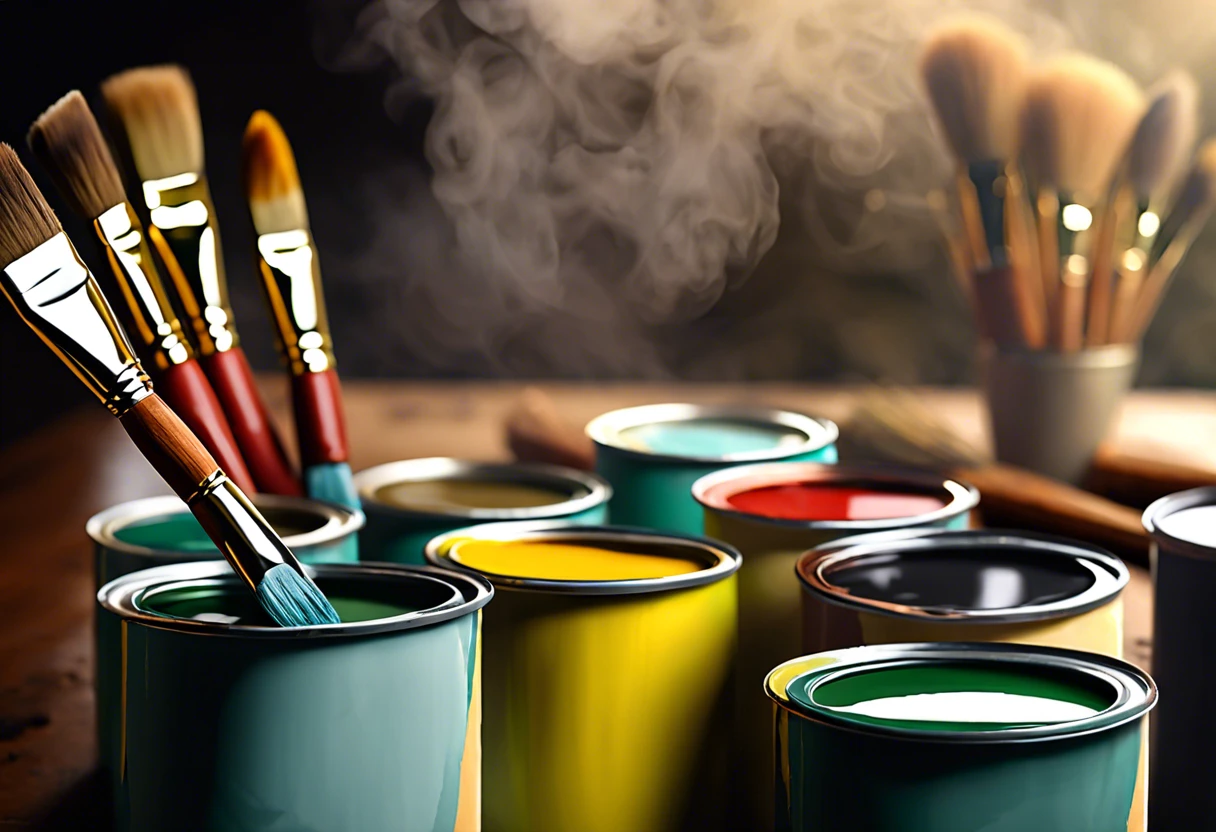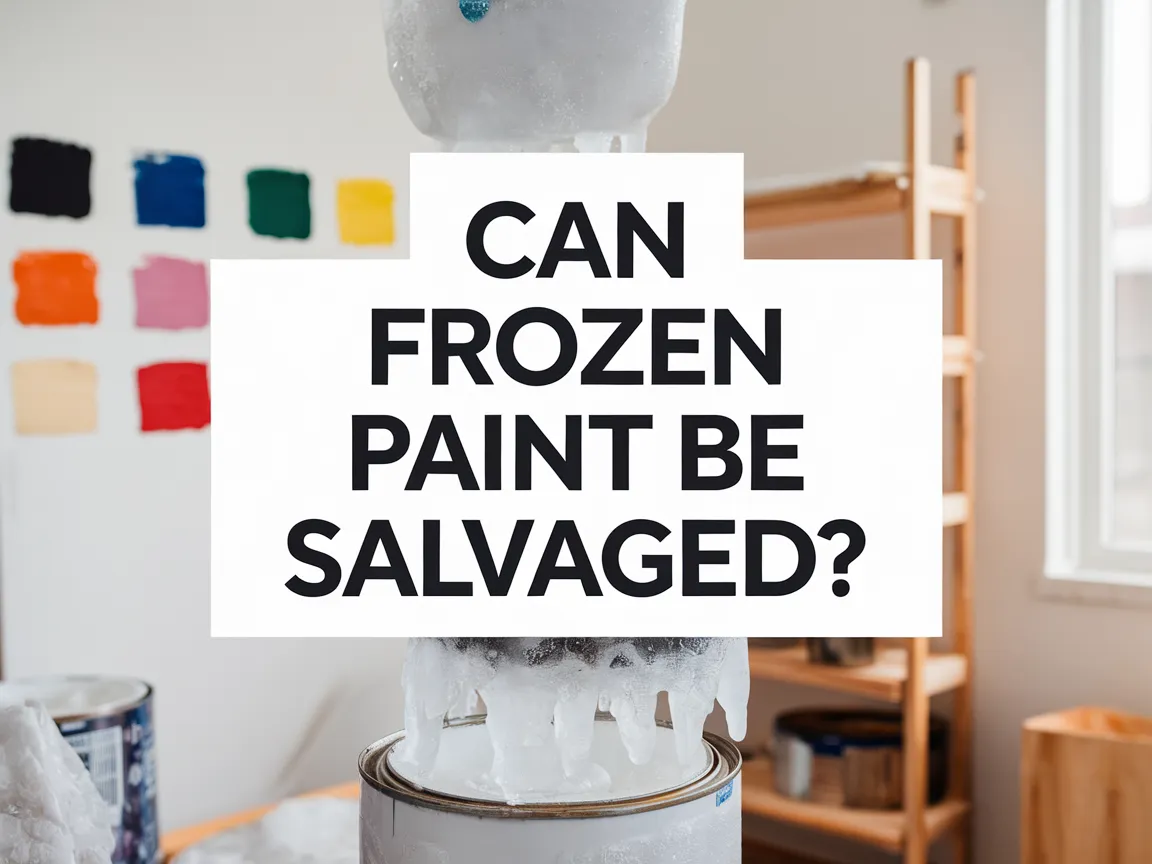Why Does It Smell Like Paint in Your House?
Published on: February 7, 2025 | Last Updated: January 7, 2025
Written By: Isabella Cruz
Paint smell? It’s that funny scent you notice when someone paints. Imagine a bright color swirling around like a happy cloud!
So, why does it smell like paint in your house? Knowing the reasons is super important for keeping your space comfy and fresh. Personally, I always find it helpful to understand where those smells come from.
In this guide, we’ll explore type of paint odors, how to deal with them, tips for improving indoor air quality, common issues, and DIY ideas for a fresh environment. Plus, we’ll cover how to get paint fumes out of your house and eliminate that pesky oil paint smell.
Contents
- 1 Why Does It Smell Like Paint in Your House?
- 2 What is ‘Paint Smell’?
- 3 Before You Start: Understanding Paint Odors
- 4 Understanding VOCs: The Culprit Behind Paint Smells
- 5 Understanding Paint Fumes: What Happens in Your Home?
- 6 The Impact of Humidity and Temperature on Paint Smell
- 7 How to Test for VOC Levels in Your Home
- 8 Steps to Identify and Mitigate Paint Smells
- 9 Types Of Paint That May Contribute to Odors
- 10 Factors Affecting the Duration Of Paint Odors
- 11 Common Issues Associated With Paint Smells in Homes
- 12 Finishing Touches: Ensuring a Fresh Environment
- 13 FAQ
- 14 Conclusion: Addressing Paint Smells Effectively
- 15 Additional Resources
Why Does It Smell Like Paint in Your House?
The smell comes from volatile organic compounds (Vocs) released during painting. These chemicals evaporate into the air and create that distinct odor. It’s common right after you paint or fix something. Regular ventilation can help reduce the smell quickly.
What is ‘Paint Smell’?
‘Paint smell’ refers to the odors released during the application and drying of paint. This scent comes mainly from volatile organic compounds (Vocs) in paint, which can make up 30% to 60% of its formulation. If you’re curious about creative ways to work with paint-related materials, you might want to explore baking salt dough crafts.
The Finishing Touch
A freshly painted wall is a blank canvas. The best way to bring your room to life is with a single piece of statement art that ties everything together.
Browse Wall Art at Big Wall DecorWhen you encounter that intense scent in your house, it’s due to these VOCs evaporating. Personally, I always reminisce about the days of painting rooms, where that smell felt both exciting and overwhelming.
I used it frequently for my job, especially for home renovations. I’ve learned that lingering odors from oil-based paints can be strong, possibly lasting for days. Understanding why your house smells like paint is crucial for eliminating those fumes and finding effective ways to ventilate the space. I once used fans and open windows, and I realized it was a great relief at the end of the day!
Before You Start: Understanding Paint Odors
What do you need to prepare for?
- High-Quality Ventilation Fan: Get a fan like the Vornado 630. It’s crucial for circulating air and reducing paint odor by moving 500 cubic feet (14.16 M³) per minute.
- Activated Charcoal Bags: Use products like Moso Natural 500g bags. They absorb strong paint fumes by about 80–90% over time!
- Respirator Mask: Equip yourself with a 3M Paint Spray Respirator. It filters out at least 95% of airborne particles, helping you breathe easier.
- Scented Candle or Air Purifier: Consider the Levoit Air Purifier. It uses a true HEPA filter to eliminate odor-causing particles, covering 129 square feet (11.99 M²) effectively.
- Thinner & Degreaser: Use products like MS Chem Thinner. It’s useful for cleaning tools, as proper cleaning prevents lingering noxious odors.
We have now covered the basics of paint odors. The next section will explore VOCs, the main cause of these smells.
Also See: Can You Die From Sleeping in a Freshly Painted Room?

Understanding VOCs: The Culprit Behind Paint Smells
Discover why VOCs are key in explaining that paint smell in your house.
-
What Are VOCs?
Volatile Organic Compounds (VOCs) are chemicals that evaporate at room temperature. These compounds are common in paints, contributing to their odors.
-
VOCs In Numbers
Did you know? VOCs can make up to 60% of a paint’s formula. When you paint, around 250 grams per liter (0.5 lbs/gal) can be released into the air!
Reducing exposure to VOCs enhances both air quality and comfort.
The Finishing Touch
A freshly painted wall is a blank canvas. The best way to bring your room to life is with a single piece of statement art that ties everything together.
Browse Wall Art at Big Wall DecorThat covers the causes of VOCs and their impact on paint odors. Let’s now take a look at paint fumes and their effects in your home.
Understanding Paint Fumes: What Happens in Your Home?
Let’s dive deeper into the science behind paint fumes in your space.
-
What Are Paint Fumes?
Paint fumes are aerosols that consist of tiny particles and chemicals released during and after the painting process. They can linger in the air for quite some time.
-
How Long Do Paint Fumes Linger?
Fumes can persist for days or even weeks. The lifespan depends on paint type, room ventilation, and humidity levels. Generally, oil-based paints emit stronger and longer-lasting fumes compared to paint health and safety considerations. If you’re wondering about specific techniques for safely curing painted items, you might want to explore acrylic paint baking methods.
We’ve wrapped up the effects of paint fumes and their behavior in your home here. Let us turn our attention to humidity and temperature’s influence on paint odor.
The Impact of Humidity and Temperature on Paint Smell
Humidity and temperature play major roles in how paint smells in your home.
| Factor | Impact on Paint Smell | Recommendation |
|---|---|---|
| Humidity | High humidity can trap odors, making them last longer. | Use a dehumidifier to maintain levels below 60% |
| Temperature | Warmer temperatures enhance the release of VOCs, increasing odors. | Keep rooms cool (around 20-22°C or 68-72°F) during and after painting. |
That covers the effects of humidity and temperature on paint odor. Let’s now take a look at testing VOC levels in your home.

How to Test for VOC Levels in Your Home
You can measure VOC levels easily—here’s how!
| Test Method | Details | Estimated Cost |
|---|---|---|
| DIY Test Kits | Use kits that you send for lab analysis. Look for specific VOC readings. | $30-50 |
| Professional Testing | Hire experts for comprehensive analysis. They provide detailed reports. | $200-500 |
| Portable Meters | Invest in handheld devices measuring real-time VOC levels and air quality. | $100-400 |
Knowing your VOC levels is vital for a healthier living space.
Steps to Identify and Mitigate Paint Smells
Here are the steps to tackle that pesky paint odor lingering in your home.
-
Identify the Source Of the Smell
First, pinpoint where the paint smell is coming from. Check for fresh paint on walls, floors, or exposed furniture. This odor often results from volatile organic compounds (Vocs) in most paints, causing a stench that might knock you off your feet.
Newer paints often contain more VOCs. If your home was painted within the last 10-14 days, these compounds may still be off-gassing, so finding the source quickly is vital for effective resolution. When working with different surface materials like aluminum, you might want to explore specific painting techniques for aluminum.
-
Ventilate the Area
Next, air out your space like it’s summer year-round. Open windows and doors for at least 15-30 minutes daily. Use a box fan to push stale air outside and pull in fresh air, which helps reduce that strong smell.
Creating airflow significantly helps; exchanging air can cut the paint smell by up to 90%. For an extra boost, consider using an air purifier with a HEPA filter to capture lingering particles.
-
Use Odor Absorbers
Common household items can save the day. Place bowls of vinegar or activated charcoal in the affected area; they absorb the paint smell effectively. An open box of baking soda can also absorb odors well! The science behind paint odor absorption relates to how different materials neutralize volatile organic compounds, which is similar to how professional painters manage color and coating techniques on specialized aircraft paint applications.
Seeing visible results feels satisfying. If you’re using paint thinner or spray paints, stepping outside occasionally can greatly improve overall indoor freshness.
Types Of Paint That May Contribute to Odors
Let’s move on to the types of paint: oil-based, latex, spray paint, and chalk paint.
-
Oil-based Paint
Oil-based paints contain solvents like mineral spirits, which can produce strong odors similar to paint thinner in your home.
-
Latex Paint
Latex paints are water-based, resulting in a milder smell. However, if you detect a rotten egg odor, it may indicate a chemical reaction.
-
Spray Paint
Spray paints release tiny paint droplets mixed with chemicals into the air, which can leave your house smelling like spray paint even after brief use.
-
Chalk Paint
Chalk paint uses a non-toxic formula, providing a more pleasant aroma. It still has some smell but is generally less intense than oil-based paints.
Looking back on my experiences, I particularly enjoy the scent of chalk paint. It doesn’t overwhelm my senses, making projects enjoyable and stress-free.
Factors Affecting the Duration Of Paint Odors
What factors contribute to the lingering paint smell in your space?
The Finishing Touch
A freshly painted wall is a blank canvas. The best way to bring your room to life is with a single piece of statement art that ties everything together.
Browse Wall Art at Big Wall Decor-
Type of Paint: Oil-based paints emit stronger odors than water-based paints.
-
Room Ventilation: Poor air circulation traps odors, prolonging the smell.
-
Humidity Levels: High humidity can intensify paint odors, making them last longer.
-
Temperature: Warmer temperatures can speed up drying but may also enhance odors.
Common Issues Associated With Paint Smells in Homes
Once, a friend painted her living room and wondered, “Why does it smell like paint in your house?” The odor came from cheap, oil-based paint—the source of the thick fumes.
To fix this, ventilate the area by leaving windows open for 24-48 hours. Use fans to circulate air. Activated charcoal, 0.5 kg (1 Lb), can absorb lingering odors, too. It’s simple and effective!
Finishing Touches: Ensuring a Fresh Environment
After dealing with paint odors, open windows to improve ventilation. Use box fans for effective airflow; aim for at least 3 m/s (6.7 Mph) to reduce lingering smells.
Start by checking for residue. Look for paint drips on surfaces, as they can retain odors. Use products like Zinsser Bin to seal any spots effectively.
I recommend using a VOC (Volatile Organic Compound) meter to measure air quality. After painting, ensure levels drop below 0.5 ppm for safety and comfort.
Apply an air-cleaning sealant over heavily painted surfaces. Choose products with titanium dioxide to chemically neutralize odors; target coverage of 15-20 m² (160-215 Ft²) per liter.
FAQ
What Causes the Smell Of Paint in a Home?
Painting your home releases paint smell due to volatile organic compounds (VOCs) in the paint composition and characteristics. VOCs are harmful substances that evaporate into the air, often leading to strong odors. These compounds can vary, with some paints having over 250 grams of VOCs per liter!
How Long Does Paint Smell Last?
The paint smell can last anywhere from a few hours to several weeks, depending on factors like ventilation and paint type. Low-VOC paints typically reduce smell duration, while oil-based paints may linger for weeks due to higher VOC levels. If you’re working on a specific project like painting an aluminum boat, you’ll want to choose the right paint for aluminum surfaces.
Is Paint Smell Harmful to My Health?
Yes, paint smell can be harmful. Exposure to high levels of VOCs can lead to headaches, dizziness, or respiratory issues. Studies show that even short-term exposure increases risks, especially in poorly ventilated areas. If you’re wondering about protecting yourself from paint fumes, key paint safety techniques can help minimize potential health risks.
How Can I Get Rid Of Paint Smell Fast?
You can eliminate paint smell fast by increasing ventilation. Open windows, use fans, and place bowls of vinegar around the room to absorb odors. Additionally, activated charcoal can help neutralize smells effectively. If you’re working with specific paint types like alkyds, knowing their unique odor characteristics can enhance your odor management strategy alkyd paint properties matter.
Can I Use Low-voc Paint to Avoid Smell?
Absolutely! Using low-VOC paint minimizes paint smell significantly. These paints contain less than 50 grams of VOCs per liter, making them a safer choice for your home and health.
Why Does My House Smell Like Paint Thinner?
Your house may smell like paint thinner due to the use of oil-based paints or solvents. These products contain strong chemicals that release odors. Ventilating your home can greatly reduce this smell.
How Do I Get Paint Fumes Out Of My House?
You can get paint fumes out of your house by increasing air circulation and using air purifiers. Natural air fresheners, like citrus peels, or baking soda can also help neutralize unwanted smells. If you’re dealing with lingering odors from a recent painting project, you might want to explore tile painting techniques that minimize fume retention.
Why Does Paint Smell Like Rotten Eggs?
If your paint smells like rotten eggs, it may contain sulfur or other components breaking down. Always check the paint label for warnings and ventilation advice.
Conclusion: Addressing Paint Smells Effectively
I hope this was worth your while. We covered why your house may smell like paint, what ‘paint smell’ means, steps to identify and mitigate paint odors, recommended color palettes for better air quality, the types of paint contributing to these odors, and the factors that affect how long these smells linger.
In short, the odor of paint in your home can arise from various sources, including the type of paint used, ventilation issues, and even moisture. By understanding how to remove paint fumes, you can create a fresher living space free from unpleasant odors.
For further information and comprehensive guides, visit Paint Answers.
Additional Resources
- Edwards, B. (2012). Drawing on the Right Side of the Brain. New York, NY: TarcherPerigee.
- House Smells Like Paint Thinner (Solved) — Karen’s Green Cleaning Minneapolis
- No More Paint Fumes: How to Get Rid of Paint Smell
- Our baby’s bedroom started smelling like paint two days ago. If you leave the door open and air out the room, the smell
Isabella is a Filipino-American art writer and critic specializing in contemporary painting, blending her Filipino heritage with global art trends. She holds a BFA from California State University, Long Beach, and a Minor in Art History from the University of the Philippines. Isa has experience as a Gallery Assistant, Art Appraisal Specialist, and Social Media Creative for Art & Design.
Health, Misc.









